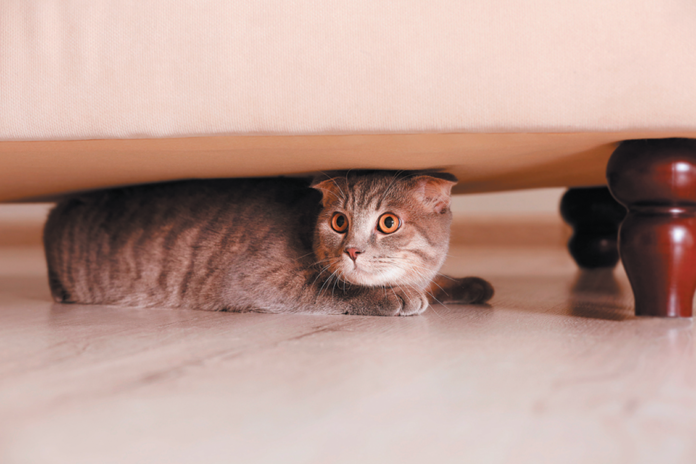Does you cat feel secure in his surroundings? Does he see the territory he inhabits as his own and feel free to move about as he would like? You can tell by the way he interacts with his environment — and with you.
A confident cat will enter a room with a relaxed posture, tail in the air, says Paws Chicago, whose mission includes setting higher standards for how animals are treated in addition to ending the overpopulation of homeless ones. He also feels good about coming right over to you when he wants attention, perhaps giving you a little butt with his head or weaving in and out of your legs.
A cat who hangs back, on the other hand, perhaps not wanting to walk across the middle of the floor, feels like an uneasy visitor in his own home. He keeps an overly respectful distance.
There are also cats who appear to assume too much ownership. There’s an aggressiveness to their stance, and they may be all too ready to defend territory they should feel comfortable to share. For instance, such a cat might lie across a doorway so that you have to walk over him to get where you want to go. Or he urine marks to say, “This is mine.” That’s not good, either. Such a cat, in fact, is just as uncertain and anxious as a cat who comes off as a shrinking violet. He is reacting preemptively because he does not feel confident that his place in the home or his rights are secure.
The aim is to help all house cats become their most confident, secure selves — to let them know that they have agency in their homes and in their lives so they can be their happiest and most relaxed. Attending to the following aspects of their daily life can help.
Adjusting the environment
Cats want to be able to anticipate threats. If their only way to do that is to hide under the bed, they’re going to have very little opportunity to acclimate to the rest of the house and have a freer life. For that reason, make sure there are places where your cat can be around the action but not in it if he chooses not to be.
Put a hide-y hole or a cardboard box just large enough for him to squeeze into either in the family room or other spot where people and other pets hang out. Also provide access to a couple of high-up spaces around the house — a high shelf or a kitty seat under a window but off the floor, perhaps. That way, your cat can feel cozy and protected while learning that the house is his, too. He will see over time that his surroundings are not something to be afraid of but rather, spaces he can enjoy. Such “nests” also will afford you the opportunity to casually say “Hi” with a brief scratch that doesn’t have your pet backing even farther into a corner. They will also help cats who “overstep” out of anxiety.
Adjusting the level of interaction
Along with making your home more conducive to comfy cozy time, you want to make sure that neither you nor others come on too strong. Don’t use your cat’s presence to overwhelm him with attention. He’ll let you know when he’s interested in interacting, and if he doesn’t, be very sparing with a bit of stroking under the chin and other polite gestures. When it comes to cats, less is often more. They don’t want to be slammed with affection — unless they specifically ask for it, and even then, it’s important to pay attention to your pet’s cues. If you’re getting the feeling he has had enough, he has.
Creating daily structure
Cats very much appreciate routine. They like to be able to depend on knowing approximately what time of day they’re going to be fed and given attention. It calms them. Try to stick to a schedule for their basic needs as well as for play time with a feather, laser beam, or other toy at a time that your cat prefers.
If there is going to be a disruption — a new person coming to the house, a new work schedule for you — keep in mind that your cat might feel unnerved by it. Even just knowing that he will be feeling stress will help you treat him sensitively when he is frazzled. Maybe you’ll want to give him a treat he especially loves, or place his favorite blanket or piece of cloth in a particularly convenient spot. Speaking softly to him might help, too.
At all times, remember that yelling and emotional chaos in the home will weigh on your cat. He may not know what’s wrong, but he’ll certainly pick up on the tone, the tension, and the lack of harmony, and it will affect him negatively — more than might meet the eye. As much as you would try not to yell and pick fights in front of a toddler, you would want to give your cat the same consideration.
Tending to the concerns outlined here will not necessarily resolve all problems for cats who are scared or anxiously aggressive in your home, but they should definitely help take things in the right direction.




